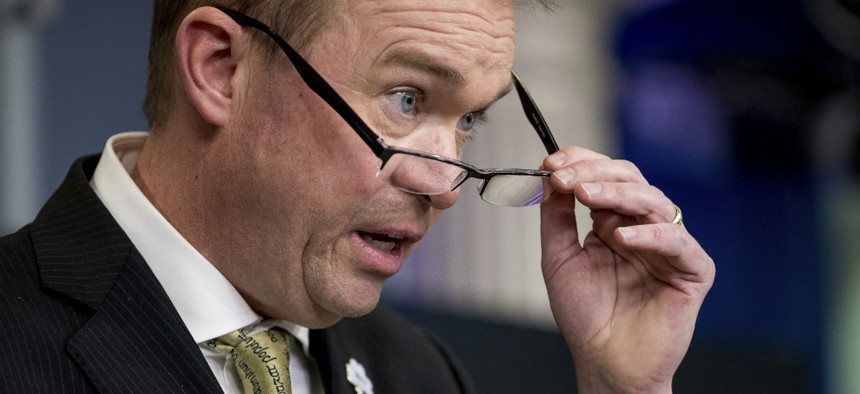
OMB Director Mick Mulvaney pushed attrition plans before as a member of Congress. Andrew Harnik/AP
Few Details Emerge on Trump's Workforce Attrition Plan, but Past Proposals May Offer Clues
Former officials overseeing attrition initiatives question the tactic's utility.
The Trump administration is offering few details on the nature of the attrition plan it has promised to deliver in a little more than two weeks, but the man heading the initiative may look to his own past to draw inspiration in his effort to reduce the size of the federal workforce.
In 2011, when he was a congressman, Office of Management and Budget Director Mick Mulvaney introduced the Reducing the Size of the Federal Government Through Attrition Act. The measure would have required federal agencies to fill just one vacancy for every three employees who left. The goal of the bill, which was approved in committee but never received a vote on the House floor, was to cut the size of the federal workforce by 10 percent over five years.
In a January presidential memorandum instituting a hiring freeze, President Trump called on the heads of OMB and the Office of Personnel Management to come up with a “long-term plan to reduce the size of the federal government's workforce through attrition.” An OPM spokesman said OMB has taken the lead on the initiative, putting Mulvaney squarely in charge of bringing about the reforms he has pushed.
OMB declined to offer any input into its thinking on the attrition plan -- a spokesman said he did not “have anything at this time” -- but the three-out, one-in policy is a popular one in Republican circles. The caucus approved multiple budgets authored by now-House Speaker Paul Ryan, R-Wis., that called for a 10 percent federal workforce reduction through attrition.
Mulvaney’s blueprint would have also reduced service contracts by 10 percent over the same five-year period and tasked OMB with keeping agencies on track for both goals. OMB would have to provide written notice to Congress and the president to ensure agencies were meeting their attrition goals before they could fill any vacancies. The Congressional Budget Office estimated the plan would save $17 billion over five years on the federal employee side, and an additional $17 billion on the contractor side.
While Trump’s memo called for the end of the current hiring freeze upon the implementation of the OMB-OPM plan, Mulvaney’s bill would have instituted a moratorium if the government failed to meets its 10 percent goal within five years. Similar to Trump’s freeze, Mulvaney’s attrition plan would have allowed for carve outs for national security and protection of public health and property.
“Our fiscal situation requires tough choices to restrain government spending,” Mulvaney and his fellow House Oversight and Government Reform Committee Republicans wrote in a report on the legislation. “Agencies must focus on their core mission, reassess priorities and direct taxpayer dollars to where they are most needed.”
The committee acknowledged the ratio of federal workers to the overall American population had declined in recent decades, but said that should not “be understood to mean that the federal government is now understaffed.” The Republicans cited a similar proposal in the President Obama-commissioned Simpson-Bowles report.
The Clinton administration instituted a workforce reduction initiative in the mid-to-late 1990s, with the goal of slashing more than 270,000 employees. Ellen Tunstall, who served as the OPM’s deputy associate director for employment policy during that period, said attrition is the “least painful” way to cut the federal workforce, but cautioned it is “not particularly strategic.”
“The peril we found across government is you can’t really control attrition,” Tunstall said. Sometimes, she explained, the employees “that you really want to keep” are the “the ones that are likely to go.”
She added: “If you can only hire one for every three back you find yourself in a bind because you can’t control where those losses occur.”
The Trump administration could attempt a more targeted approach, offering retention incentives to the areas in which it wants to keep employees on board. Tunstall, now a senior adviser at FMP Consulting, noted getting serious about “dealing with performance issues,” early retirement incentives and buyouts could enable a more focused strategy. Such policies, however, could offset the savings the administration is striving to achieve.
Sean Morris, who runs the federal human capital practice at Deloitte and has consulted with federal agency clients for 20 years, said agencies should use workforce analytics to understand what types of skills their employees have, how close they are to retirement, what their career goals are and other details. Many agencies have not changed their basic structures in decades, he said, and a push for attrition can actually create an opportunity for agencies to reshape themselves to adjust to modern developments.
“Organizations can go through these types of activities and come out the other end in as strong a position or potentially better,” Morris said, “if it’s done right.” He added if agencies address forthcoming requirements “without the entire picture, they may not make the best decision.”
Agencies’ workloads, Tunstall said, are not going away. Officials will be forced to engage in workforce planning and determine what they can no longer do. In her experience, Tunstall, who led civilian personnel policy at the Defense Department after her time at OPM, saw agencies dealing with mandatory attrition measures and hiring freezes promote underserving employees.
“You can’t hire from outside so you promote,” she said. “[Agencies] promoted because they were there and available, not because they were the kind of folks you needed.” She added that creates a problem “for years to come.”
Morris encouraged agencies to take a proactive approach in identifying all elements of their workforces to mitigate those types of risks.
Agencies, he said, can “effect change rather than being affected by change.”
NEXT STORY: Why You Should Care About Open Data







